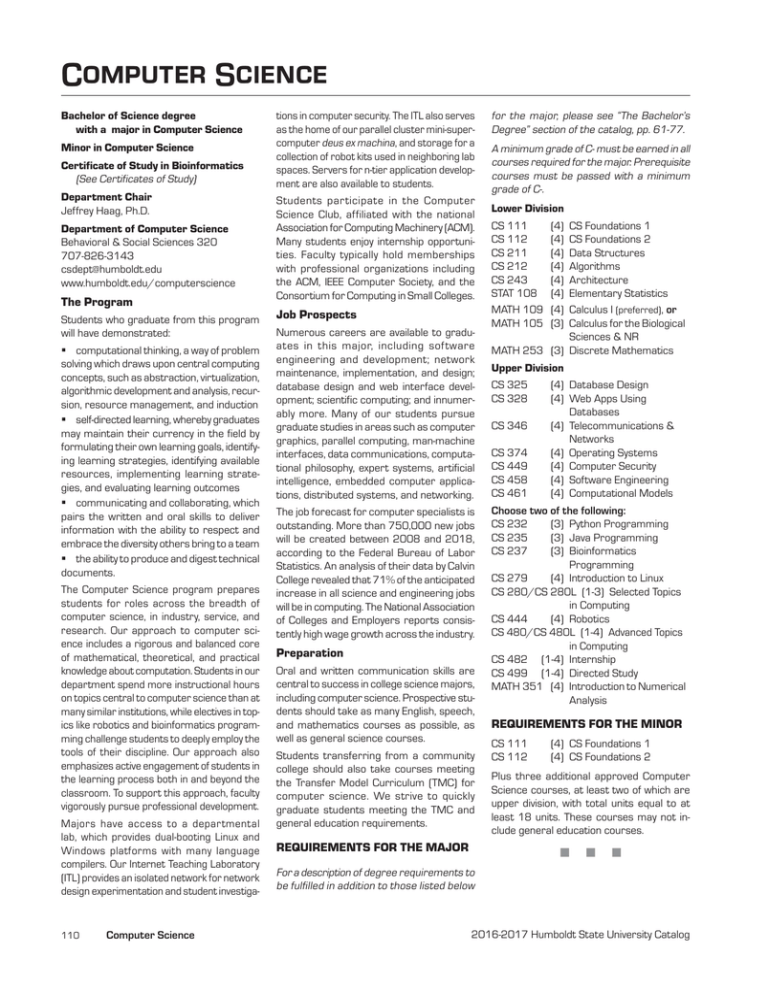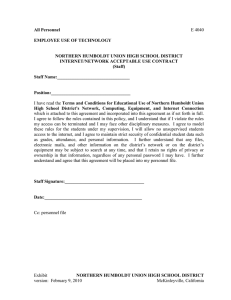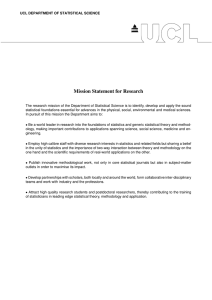Computer Science - Humboldt State University
advertisement

Computer Science Bachelor of Science degree with a major in Computer Science Minor in Computer Science Certificate of Study in Bioinformatics (See Certificates of Study) Department Chair Jeffrey Haag, Ph.D. Department of Computer Science Behavioral & Social Sciences 320 707-826-3143 csdept@humboldt.edu www.humboldt.edu/computerscience The Program Students who graduate from this program will have demonstrated: computational thinking, a way of problem solving which draws upon central computing concepts, such as abstraction, virtualization, algorithmic development and analysis, recursion, resource management, and induction self-directed learning, whereby graduates may maintain their currency in the field by formulating their own learning goals, identifying learning strategies, identifying available resources, implementing learning strategies, and evaluating learning outcomes communicating and collaborating, which pairs the written and oral skills to deliver information with the ability to respect and embrace the diversity others bring to a team the ability to produce and digest technical documents. The Computer Science program prepares students for roles across the breadth of computer science, in industry, service, and research. Our approach to computer science includes a rigorous and balanced core of mathematical, theoretical, and practical knowledge about computation. Students in our department spend more instructional hours on topics central to computer science than at many similar institutions, while electives in topics like robotics and bioinformatics programming challenge students to deeply employ the tools of their discipline. Our approach also emphasizes active engagement of students in the learning process both in and beyond the classroom. To support this approach, faculty vigorously pursue professional development. Majors have access to a departmental lab, which provides dual-booting Linux and Windows platforms with many language compilers. Our Internet Teaching Laboratory (ITL) provides an isolated network for network design experimentation and student investiga- 110 Computer Science tions in computer security. The ITL also serves as the home of our parallel cluster mini-supercomputer deus ex machina, and storage for a collection of robot kits used in neighboring lab spaces. Servers for n-tier application development are also available to students. Students participate in the Computer Science Club, affiliated with the national Association for Computing Machinery (ACM). Many students enjoy internship opportunities. Faculty typically hold memberships with professional organizations including the ACM, IEEE Computer Society, and the Consortium for Computing in Small Colleges. Job Prospects Numerous careers are available to graduates in this major, including sof tware engineering and development; network maintenance, implementation, and design; database design and web interface development; scientific computing; and innumerably more. Many of our students pursue graduate studies in areas such as computer graphics, parallel computing, man-machine interfaces, data communications, computational philosophy, expert systems, artificial intelligence, embedded computer applications, distributed systems, and networking. The job forecast for computer specialists is outstanding. More than 750,000 new jobs will be created between 2008 and 2018, according to the Federal Bureau of Labor Statistics. An analysis of their data by Calvin College revealed that 71% of the anticipated increase in all science and engineering jobs will be in computing. The National Association of Colleges and Employers reports consistently high wage growth across the industry. Preparation Oral and written communication skills are central to success in college science majors, including computer science. Prospective students should take as many English, speech, and mathematics courses as possible, as well as general science courses. Students transferring from a community college should also take courses meeting the Transfer Model Curriculum (TMC) for computer science. We strive to quickly graduate students meeting the TMC and general education requirements. REQUIREMENTS FOR THE MAJOR for the major, please see “The Bachelor’s Degree” section of the catalog, pp. 61-77. A minimum grade of C- must be earned in all courses required for the major. Prerequisite courses must be passed with a minimum grade of C-. Lower Division CS 111 CS 112 CS 211 CS 212 CS 243 STAT 108 MATH 109 MATH 105 (4) (4) (4) (4) (4) (4) (4) (3) CS Foundations 1 CS Foundations 2 Data Structures Algorithms Architecture Elementary Statistics Calculus I (preferred), or Calculus for the Biological Sciences & NR MATH 253 (3) Discrete Mathematics Upper Division CS 325 CS 328 CS 346 CS 374 CS 449 CS 458 CS 461 (4) Database Design (4) Web Apps Using Databases (4) Telecommunications & Networks (4) Operating Systems (4) Computer Security (4) Software Engineering (4) Computational Models Choose two of the following: CS 232 (3) Python Programming CS 235 (3) Java Programming CS 237 (3) Bioinformatics Programming CS 279 (4) Introduction to Linux CS 280/CS 280L (1-3) Selected Topics in Computing CS 444 (4) Robotics CS 480/CS 480L (1-4) Advanced Topics in Computing CS 482 (1-4) Internship CS 499 (1-4) Directed Study MATH 351 (4) Introduction to Numerical Analysis REQUIREMENTS FOR THE MINOR CS 111 CS 112 (4) CS Foundations 1 (4) CS Foundations 2 Plus three additional approved Computer Science courses, at least two of which are upper division, with total units equal to at least 18 units. These courses may not include general education courses. For a description of degree requirements to be fulfilled in addition to those listed below 2016-2017 Humboldt State University Catalog

